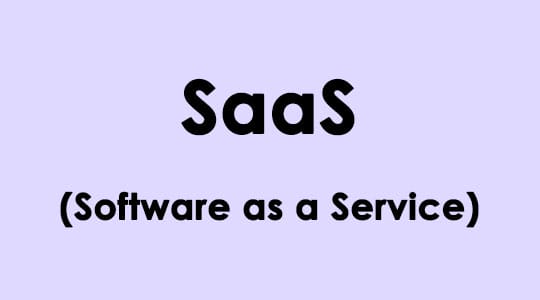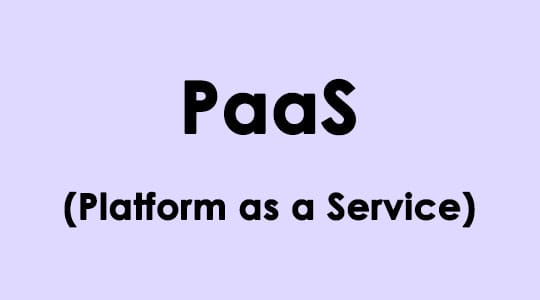In today’s technology-oriented world, cloud computing has a vital role to manage enterprise workloads. It is a broad concept that comprises a wide range of models ranging from SaaS, PaaS to IaaS. Today, every business wants to adopt cloud services that match their organization goal. Choosing a perfect cloud service is definitely a challenging task and you need to consider several parameters before making a final decision. If you are planning to use cloud services for your business then it is really essential to know the key differences between all these cloud models. Here we have discussed all the advantages and disadvantages of SaaS, PaaS, and IaaS that will give you a perfect understanding of which model to choose for your business. Simply browse through below details and check out all the comparison done with suitable examples that will make your concept extremely clear about these cloud models:
What is SaaS (Software as a Service):

SaaS (wiki) is recognized as the most common model of cloud computing that offers access to cloud-based software to the user. SaaS software is located on a distant cloud network which can be easily accessed using APIs and web. Users can take the help of applications to collaborate on different projects and store their data very easily. The SaaS vendor looks after all the activities such as app functioning and hardware stability. Clients don’t have any role to play in the cloud model and they can only access the program to finish their work tasks.
SaaS is kind of unique cloud servicing model in which users don’t need to install or download SaaS apps on their devices and they can access everything using plug-ins. The services of the SaaS model are available on a subscription basis and your application is good to go once you get logged in using your username and password. SaaS is considered as a highly appreciated form of cloud delivery as more than 50% of the organizations are already using services of SaaS. It lets the user avail all cloud-based services without any requirement to manage the primary infrastructure.
Recommended for you: Startup Inspiration: TOP 9 SaaS Startups that Became Successful.
Advantages of SaaS:
- It doesn’t involve any hardware and set up cost as users don’t need to install any software or hardware in their device.
- You can get automated software upgrades on a regular basis. If there are any technical issues or bugs, the vendor will look after them and you can focus on your goal instead of worrying about maintenance.
- The cloud service of SaaS is easily accessible from the location of your choice where internet services are available.
- SaaS services can be availed from any device as you can get going simply after log in. You can even have the flexibility to access cloud-based services from mobile devices with the help of apps.
- When it comes to scalability, there is nothing that can match the SaaS model.
- The pricing structure of SaaS services follows the subscription model. So, users can easily estimate in advance what their monthly or yearly service cost will be. If you want any additional functionality then you have an option to update your plan.
- It is very easy to customize as adopting all services of SaaS is a cakewalk for you. Users don’t need to have any special technical skills in order to get going.
- The services of SaaS are quite affordable when compared with on-premises software.
- It is a perfect fit for small and medium businesses that don’t rely on a huge IT team.
- The vendor looks after all issues related to software and infrastructure.
Disadvantages of SaaS:
- User doesn’t have any control over the hardware that looks after the data.
- Only a vendor has access to parameters of software that a client is using.
- Sometimes users face restrictions over a range of services.
- In order to avail services of SaaS for your business, you need to have sufficient internet connectivity.
- In a few cases, staff may access application of SaaS without taking approval from IT which means the data stored is less secure.
- Sometimes, you may find it difficult to integrate SaaS applications with the tool or software which your organization is using.
- Users may need to pay subscription fees even though they have accessed services on an occasional basis or never before.
- In the case of SaaS, there is also a high chance of vendor lock-in.

When to Choose SaaS?
- For projects which have short term goals and require collaboration up to a significant extent.
- For applications which require mobile as well as web access.
- It is highly suitable for businesses which have limited IT, staff.
- SaaS can be beneficial if you are planning to use apps on a provisional basis.
- If an organization wants to release software within quick time.
- It is best for replacing a specific kind of business software.
- SaaS solutions can be used for personal objectives such as email services, cloud storage purpose and file management solutions.
- Businesses can employ SaaS Services for corporate emails, CRM software, ERP and collaboration tools.
Examples of SaaS:
There are several vendors that offer SaaS solutions and some of them include Cisco WebEx, Salesforce, Dropbox, Google Apps, GoToMeeting, Gmail, Office365, etc.
What is PaaS (Platform as a Service):

PaaS (wiki) is referred to as a cloud platform that offers runtime environment for testing, developing, running and customizing applications. On the virtue of PaaS solutions, developers can easily deploy applications without the requirement of any infrastructure. PaaS vendors pass on total infrastructure require for app development where software developers are in control of the code.
Similar to SaaS, PaaS follow subscription-based pricing model but the key difference lies in the level of control offered to users.
“PaaS vendors look after security problems, backup issues, system updates and manage servers. What it means that clients can give complete attention to application development without concerning about infrastructure and maintenance.” – as Alexander Beresnyakov, the Founder & CEO at Belitsoft stated in his recent interview.
PaaS passes on a bit of more responsibility for IT management from client to cloud vendor.
Though PaaS is presently the least recognized cloud computing model, it is growing in quick numbers. According to recent research, more than 25% of businesses use PaaS in their production process and over 50% of organizations have plans to set up in the future.
You may like: Microsoft Azure vs Amazon AWS – What Best for Your Career in 2019-20?
Advantages of PaaS:
- PaaS demands a lesser amount of time and average skills for management. The biggest benefit of PaaS over other cloud computing models is that it can catalyze the development of new applications.
- In the case of PaaS, server-side elements required for computing infrastructure are offered by the vendor. It means development department doesn’t need to worry about installing, updating and maintaining them. This allows them to centralize all their focus on executing projects with top quality and high speed.
- PaaS cloud model supports a number of programming languages that gives software developers a chance to execute multiple projects on a similar platform.
- For remote teams, PaaS also offers amazing exposure to get collaborated with core teams. Most of the organizations have specialists who work as a freelancer from a distant location. PaaS cloud model gives them easy access to main software from any place of their choice at any time.
- PaaS offers software companies all the resources they require to develop applications and they don’t need to hire any extra staff for doing this. All middleware and hardware are offered, upgraded and maintained by the vendor which means organizations don’t need to hire dedicated staff to install servers and manage the operating system.
- PaaS is the perfect option for app development teams which are focusing on developing cloud-based apps. It is mostly accepted and appreciated by DevOps teams.
- In the case of PaaS, resourcing can be easily increased or decreased according to business needs. It is highly scalable. The database and web services are also perfectly integrated into the PaaS.
- The expenses involved in developing, testing and realizing apps are quite low when compared with other cloud-based models. The amount of time required for coding is also significantly low in case of PaaS.
- If you want to migrate to the hybrid cloud then you can do it smoothly on the virtue of PaaS.
Disadvantages of PaaS:
- The client has zero control over the virtual machine that looks after the data.
- When compared with IaaS, you will find PaaS solutions less flexible.
- PaaS may incur you unexpected charges depend upon your requirement.
- It provides low customer control and less flexibility than IaaS.
- PaaS cloud model does require basic coding skills and programming knowledge to deploy it successfully into the system.
- You may face a few data security concerns while deploying PaaS cloud model.
- In certain cases, compatibility issues for infrastructure can be observed as you can’t make every single component cloud-enabled.
- You have to heavily rely on the support of the vendor.

When to Choose PaaS:
- PaaS is effective for software developers who want to dedicate more time on coding, deploying and customizing applications.
- It is extremely beneficial when huge numbers of software developers are working on a single project.
- If you want to develop your own customized application then PaaS cloud model is the preferred choice over others.
- PaaS offers a perfect environment for developing, managing, testing and customizing apps that makes it an ideal choice for software companies.
- PaaS is the preferred option when you want to add some other vendors into the process.
- It is perfectly suitable for businesses having in house apps.
Example of PaaS:
There are several well-recognized PaaS solutions you will find in the market. Some of them include OpenShift, Heroku, Apache Stratos, AWS Elastic Beanstalk, Windows Azure Cloud Services, Amazon AWS, and Google App Engine. IaaS offers you a huge amount of control but it demands high expertise from the user in order to look after computing infrastructure.
What is IaaS (Infrastructure as a Service):

IaaS (wiki) is a kind of virtual data center that offers computing infrastructure such as storage, servers and several key networking resources. This is extremely lucrative for users as they don’t need to purchase dedicated hardware and customize its components. In fact, clients can easily install their application into the virtual machine of the vendor that provides functionality very similar to physical data hub.
You can use an IaaS solution for different purposes such as analyzing complicated data and hosting multiple websites. You are allowed to install and run a different kind of tools and OS on the infrastructure provided. Presently, IaaS is listed as the most popular cloud computing model after SaaS. According to the latest research done by experts, more than 35% of businesses are using IaaS model in production and around 50% of organizations are planning to use it in coming time.
Though the IaaS service provider looks after the overall infrastructure, clients can gain entire control over it. In fact, the client is accountable for installing, managing and maintaining applications. They also have a vital role to play in runtime, security, data, and middleware. Besides this, IaaS users have the luxury to compare the performance and price of multiple service providers before finalizing the right option. They can access all such important data through a dedicated API.
You may also like: A Quick Guide to IT Networks – 22 Important Terms Related to Networking.
Advantages of IaaS:
- The biggest advantage of IaaS lies in customization and flexibility it provides. Some of the vendors even provide different kinds of storage and computing options that let users choose performance parameters that match their specific requirements. Most of the vendors offer an alternative of metal servers that let users install cloud servers simply the way they desire.
- IaaS comes with high customization ability that lets the user to easily install cloud services which they can match with the data center of the organization. On the virtue of this facility, users can easily migrate their apps to the cloud and deploy them very easily. Clients can create a hybrid cloud environment and integrate existing data with their software or tools.
- Out of all three cloud models, the issue of vendor lock-in is extremely low in the case of IaaS. It is considered as one of the dynamic and highly flexible cloud models.
- The cost incurred on services is directly proportional to the amount of consumption. What it means that you can keep a check on the cost as you will be charged only for the resources or services you use.
- In the case of IaaS, the user gets total control over the infrastructure which is not the case with other cloud models.
- Multitenant architecture is another benefit that comes with IaaS that allow you to use a single element of hardware for multiple users.
- As the installation of hardware is done on an automated basis, you will find IaaS extremely convenient to use.
- In most of the cases, the management workload is virtualized, which means they can save a significant amount of time and focus on their other tasks.
- IaaS means you don’t need to worry about the security. The vendor is responsible for the safety of your vital data and they give a total guarantee about its security. All the hardware infrastructure is kept under specially designed and well-protected data centers.
Disadvantages of IaaS:
- The IT team of the organization needs to look after the issues such as IT slack. Besides this, IaaS demands a certain level of technical skills and time from developers that will increase the overall cost of the organization. All these factors make expenses of IaaS highly unpredictable.
- Sometimes, IaaS is more costly than other cloud platforms as you need to take the entire hardware infrastructure on lease.
- Any form of vendor outages means users can’t access any form of data until the services resume. Any problems occurred related to the virtual machine is also the responsibility of the user.
- Organizations need to give sufficient amount of training to their IT team to make them familiar with the management of entire infrastructure.

When to Choose IaaS:
- IaaS can be used for application or website hosting purpose.
- IaaS is an ideal solution for creating virtual data centers for big enterprises that require highly scalable, efficient and secure server environment.
- When you need to analyze a large database, you definitely need outstanding computing power. This is exactly where IaaS comes into the picture as it offers the most affordable way to get it done. Organizations can also use infrastructure as a resource for the purpose of data analysis and mining.
- IaaS is extremely beneficial for small enterprises that haven’t kept any dedicated budget for developing their own infrastructure.
- IaaS can be also effective if you are running a rapidly growing organization. Even if you are demands are variable, IaaS can get the job done for you very smoothly.
- If you are running a big organization that wants total control over key infrastructure but needs to pay only for the services used.
- It is most suitable for businesses that want to transform their current workload to the cloud.
- Businesses having current software licenses which can be migrated to cloud.
- It is also ideal for hybrid cloud settings.
- Big companies having a huge number of IT staff will find the IaaS platform more appropriate over others.
Examples of IaaS:
Some of the best examples of IaaS include Rackspace, Linode, DigitalOcean, Cisco Metapod, Amazon Web Services, Google Compute Engine, and Microsoft Azure.
SaaS vs PaaS vs IaaS: Key Differences with Examples
If your organization is looking for a platform to develop software products then you can choose PaaS. In case your company requires unique software, you can opt for SaaS. If you are running a business that requires only a virtual machine then IaaS will be more suitable for you.
PaaS is used by developers; IaaS is suitable for system administrators, while SaaS is used by end-users. Most of the huge organizations prefer to use SaaS applications such as Salesforce and Microsoft Office 365. They may prefer to migrate their in-house apps to IaaS and create user-end applications using PaaS.
| SaaS | PaaS | IaaS | |
|---|---|---|---|
| What users can avail | Applications and website software to finish business tasks | Tools and virtual platform to develop, customize and install apps | The datacenter that can store enormous data and develop platforms for app testing and installation |
| What Provider controls | Servers, networking, middleware, application, operating system, storage, and data | Storage, servers, virtualization, networking, operating system, middleware | Storage, servers, virtualization, networking |
| What user controls | Data, apps | Data, apps, middleware, operating system |
Recommended for you: 9 Ways eCommerce Businesses Can Address the Privacy Concerns of Customers.
Conclusion:

After going through all the information mentioned above, you will realize the importance of cloud services and why it is so popular among businesses. The benefits of cloud solutions are extremely high and no wonder why the cloud services industry is showing such a drastic boom. The decision of selecting any one model out of the above-mentioned list is completely based on your business requirement and the kind of task you want to execute.
Cloud computing has given birth to several technical terms but there is nothing more important than IaaS, PaaS, and SaaS. They are considered as three important pillars which are supporting cloud computing. The final choice out of these three models totally depends upon your business objectives. Most of the companies even end up using all three solutions while few organizations prefer to stick with one model. So, first of all, list down what your organization needs and then try to match your requirement with the services offered by all three cloud-based models. The solution that fulfills the maximum number of objectives can be an ideal choice for your business.
Each of the three cloud models comes with its own characteristics and features. It is extremely important to understand the key differences between them. Whether you are looking for cloud mode for storage purpose, an effective platform to develop customized apps or wish to have total control over infrastructure, you need to choose the right cloud service. No matter which alternative you select, migrating to cloud services is the demand of the situation to keep your business well organized. You may opt for a single cloud computing model or seek services of all three models. It depends upon the complexity and size of your organization.





